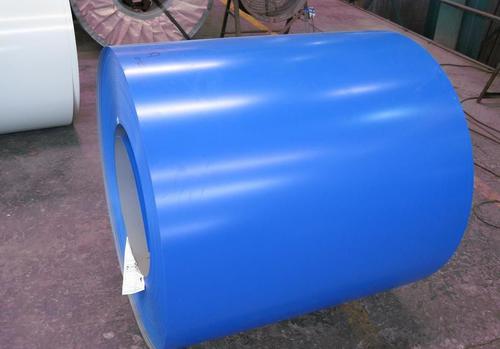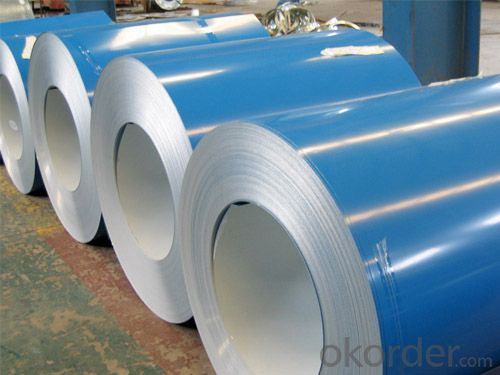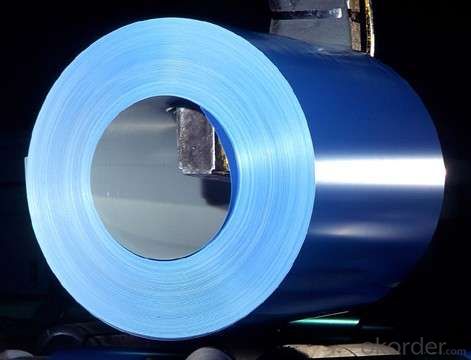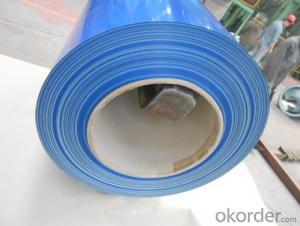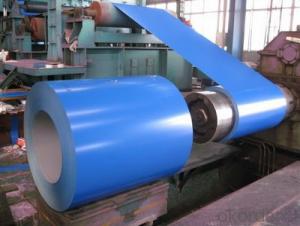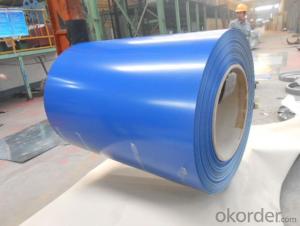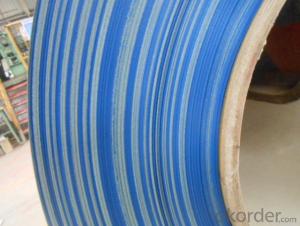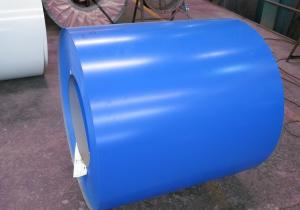PPGI Color Coated Galvanized Steel Coil Blue Color Prime Quality
- Loading Port:
- Shanghai
- Payment Terms:
- TT OR LC
- Min Order Qty:
- 200 m.t.
- Supply Capability:
- 20000 m.t./month
OKorder Service Pledge
OKorder Financial Service
You Might Also Like
1. Pre-Painted Galvanized/Aluzinc Steel Coil Description:
With GI as base material, after pretreatment (degrease and chemical treatment ) and liquid dope with several layers of color, then after firing and cooling, finally the plate steel is called pre-painted galvanized (aluzinc) steel. Pre-painted galvanized steel is good capable of decoration, molding, corrosion resistance. It generally displays superior workability, durability and weather resistance.
2.Main Features of the Pre-Painted Galvanized/Aluzinc Steel Coil:
• Excellent process capability
• Smooth and flat surface
• Workability, durability
• Excellent heat resistance performance
• High strength
• Good formability
• Good visual effect
3.Pre-Painted Galvanized/Aluzinc Steel Coil Images
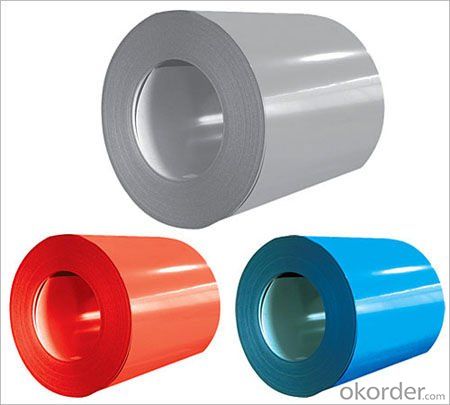
4.Pre-Painted Galvanized/Aluzinc Steel Coil Specification
Standard: AISI, ASTM, BS, DIN, GB, JIS
Grade: DX51D, DX52D
Thickness: 0.17-2.0mm
Brand Name: KMRLON
Model Number: coil
Type: Steel Coil
Technique: Cold Rolled
Surface Treatment: Coated
Application: Boiler Plate
Special Use: High-strength Steel Plate
Width: 20-1250mm
Length: customized
commoidty: pre-painted galvanized steel coil
Thickness: 0.13-4.0mm
width: 20-1250mm
zinc coating: 40-180g/m2
printing thickness: top side: 20+/-5 microns, back side: 5-7 microns
color: all RAL color
surface treatment: color coated
coil weight: 4-7 tons
coil ID: 508/610mm
packaging: standard seaworthy packing
5.FAQ of Pre-Painted Galvanized/Aluzinc Steel Coil
1. What’s the application of this product?
Roof, roof structure, surface sheet of balcony, frame of window, etc.
2. What’s the brand of the paint?
We use the best brand of all of the word—AKZO.
3. How about your company?
A world class manufacturer & supplier of castings forging in carbon steel and alloy steel,is one of the large-scale professional investment casting production bases in China,consisting of both casting foundry forging and machining factory. Annually more than 8000 tons Precision casting and forging parts are exported to markets in Europe,America and Japan. OEM casting and forging service available according to customer’s requirements.
4. How to guarantee the quality of the products?
We have established the international advanced quality management system,every link from raw material to final product we have strict quality test;We resolutely put an end to unqualified products flowing into the market. At the same time, we will provide necessary follow-up service assurance.
5. How long can we receive the product after purchase?
Usually within thirty working days after receiving buyer’s advance payment or LC. We will arrange the factory manufacturing as soon as possible. The cargo readiness usually takes 15-25 days, but the shipment will depend on the vessel situation.
- Q: benchmade mpr with m390 steel knife. Is it better than d2 s30v or 154cm steel?
- From what I read M390 is relatively wear resistant, with very high stain resistance and good toughness. It is quite hard to qualify steel as better than other steel because it depends on many factors. E.g. for a small folder designed for delicate cutting D2 at high hardness would perform better, but if the environment is corrosive, like saltwater then M390 would be better. I'm not so sure about using stainless steels in large chopping style knives, but I've seen M390 used for them as well. Obviously hardness had to be lowered, which reduces edge holding ability, especially at low angles. Overall, it's a good steel, but if it will outperform S30V or D2 or 154Cm depends on heat treatment and blade geometry, knife designed use, etc.
- Q: What are the different types of coil leveling machines?
- There are three main types of coil leveling machines: precision levelers, corrective levelers, and stretcher levelers.
- Q: Can steel coils be coated with anti-static materials?
- Yes, steel coils can be coated with anti-static materials. These materials are specifically designed to reduce or eliminate static electricity buildup on the surface of the steel coils, which can be beneficial in various industrial applications where static discharge can cause damage or safety hazards.
- Q: What are the different finishes available for steel coils?
- Steel coils are available in various finishes, each with its own unique characteristics and advantages. Some of the most commonly used finishes include the following: 1. Hot-dip galvanized: In this finish, the steel coil is immersed in molten zinc, creating a protective layer that prevents rust and corrosion. It offers excellent durability and long-term protection against harsh environmental conditions. 2. Electro-galvanized: Similar to hot-dip galvanizing, this finish involves using an electric current to apply a thin layer of zinc onto the steel coil. It provides good corrosion resistance and aesthetics, making it suitable for different applications. 3. Galvannealed: This finish combines the benefits of galvanizing and annealing processes. The steel coil is first galvanized and then annealed, resulting in a matte grey appearance with enhanced paint adhesion. Galvannealed finishes are commonly used in the automotive and appliance industries. 4. Pre-painted: Also known as coil coating, this finish includes applying a layer of paint onto the steel coil before it is formed into its final product. Pre-painted finishes offer a wide range of colors, textures, and gloss levels, allowing for customization and improved aesthetics. 5. Stainless steel: Steel coils can also be finished with a layer of stainless steel, which provides excellent resistance to corrosion, heat, and chemicals. Stainless steel finishes are often used in applications that require hygiene, durability, and a high-quality appearance, such as in the food and beverage industry. 6. Cold-rolled: To achieve this finish, the steel coil is passed through a series of rollers at room temperature, resulting in a smooth and polished surface. Cold-rolled finishes offer improved dimensional accuracy, surface quality, and flatness, making them suitable for applications that require tight tolerances and a refined appearance. 7. Metallic coated: In this finish, a layer of metallic coating, such as aluminum or zinc-aluminum alloy, is applied to the steel coil. Metallic coated finishes provide excellent corrosion resistance, lightweight properties, and aesthetic versatility. The choice of finish for steel coils depends on specific application requirements, considering factors such as corrosion resistance, aesthetics, durability, and cost-effectiveness. It is important to consult industry experts and manufacturers to determine the most suitable finish for a particular project.
- Q: How are steel coils made?
- Steel coils are made through a process called hot rolling, where steel slabs are heated and passed through a series of rollers to reduce their thickness and increase their length. These coils are then cooled and coiled into large rolls, ready for use in various industries such as automotive, construction, and manufacturing.
- Q: What are the common packaging methods for steel coils?
- The common packaging methods for steel coils include wooden pallets, steel strapping, and protective wrapping such as shrink wrap or stretch film. Additionally, steel coils are often secured with steel bands or wire ties to ensure stability during transportation and storage.
- Q: How are steel coils inspected for surface defects after processing?
- Steel coils are inspected for surface defects after processing using various methods such as visual inspection, magnetic particle inspection, dye penetrant inspection, and ultrasonic testing. These techniques help identify any irregularities or defects on the surface of the coils, ensuring the quality and integrity of the final product.
- Q: What are the safety standards for steel coil manufacturing?
- The safety standards for steel coil manufacturing are designed to ensure the well-being and protection of workers, as well as the quality and reliability of the products produced. These standards encompass various aspects of the manufacturing process and cover both general safety guidelines and industry-specific requirements. One of the main safety standards for steel coil manufacturing is the implementation of proper machinery and equipment safeguards. This includes ensuring that all machinery and equipment used in the manufacturing process are properly maintained, regularly inspected, and equipped with safety features such as emergency stop buttons and safety guards. Workers should also receive adequate training on the safe operation of these machines and be aware of potential hazards. Another important safety standard is the use of personal protective equipment (PPE). Workers involved in steel coil manufacturing should be provided with appropriate PPE, such as safety goggles, gloves, ear protection, and protective clothing, to protect them from potential hazards such as flying sparks, noise, and chemical exposure. Additionally, safety standards for steel coil manufacturing emphasize proper handling and storage of materials. This includes guidelines on how to safely lift and transport heavy steel coils, as well as rules for stacking and storing them to prevent accidents and injuries. Fire safety is also a crucial aspect of the safety standards for steel coil manufacturing. Measures should be in place to prevent and control fires, including regular inspections of electrical systems, proper storage and handling of flammable materials, and the presence of fire extinguishers and emergency evacuation plans. Furthermore, safety standards require regular safety training and awareness programs for all employees involved in steel coil manufacturing. This ensures that workers are well-informed about potential hazards, safety procedures, and emergency protocols. Regular safety audits and inspections are also conducted to assess compliance with these standards and identify areas for improvement. Overall, the safety standards for steel coil manufacturing aim to create a safe working environment, reduce the risk of accidents and injuries, and ensure the production of high-quality steel coils. Compliance with these standards is essential for maintaining the well-being of workers, protecting the environment, and maintaining the reputation of the manufacturing industry.
- Q: What are the challenges in storing and handling steel coils?
- Storing and handling steel coils present several challenges, including their sheer weight and size, which can make transportation and storage difficult. The coils need to be stored in a way that prevents damage and deformation, as steel coils are susceptible to rust, corrosion, and scratching. Additionally, ensuring proper ventilation and moisture control is crucial to prevent the growth of mold or moisture-related damage. Safety precautions must also be taken during handling and transportation to avoid accidents or injuries.
- Q: What are the common methods of welding steel coils?
- The common methods of welding steel coils include arc welding, resistance welding, and laser welding.
Send your message to us
PPGI Color Coated Galvanized Steel Coil Blue Color Prime Quality
- Loading Port:
- Shanghai
- Payment Terms:
- TT OR LC
- Min Order Qty:
- 200 m.t.
- Supply Capability:
- 20000 m.t./month
OKorder Service Pledge
OKorder Financial Service
Similar products
Hot products
Hot Searches
Related keywords



